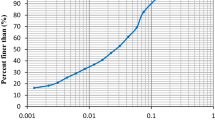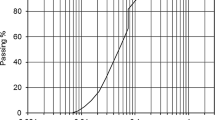Abstract
In this study, gasoil-contaminated clayey sand samples improved with clay nanoparticles in two hydrophilic and organophilic states were cured for 7, 14, and 28 days and were subjected to uniaxial compressive strength (UCS) tests. For this purpose, first, clean soil samples were contaminated with various percentages of gas–oil. The results showed that the unconfined compressive strength of the samples decreases with the increase in soil contamination percentage for all three curing periods. According to the results, the highest decrease of UCS is obtained in the soil with 6 and 8% contamination. Then, by adding different percentages of nanoclay and organoclay to soil contaminated with 6 and 8% gas–oil, we tried to improve the lost properties of the soil. According to results of standard compaction tests, combining contaminated with nanoclay and organoclay could decrease maximum dry density while increasing optimum water. But organoclay had a greater effect than nanoclay on the compaction properties of contaminated soil which can be attributed to the organophilic nature of the organoclay. Based on the results, the compressive strength of the treated samples was increased due to curing. Also, the peak strain corresponding to the UCS decreased during the 28-day curing period compared to the samples with a 7-day curing period. Based on the results, 2 and 0.7 weight percent of clayey sand contaminated with 6 and 8% of gas–oil were found as optimum values for nanoclay and organoclay, respectively. These results were investigated and confirmed by scanning electron microscopy imaging.














Similar content being viewed by others
References
Estabragh, A.R.; Kholoosi, M.; Ghaziani, F.; Javadi, A.A.: Mechanical and leaching behavior of a stabilized and solidified anthracene-contaminated soil. J. Environ. Eng. 144(2), 04017098 (2018). https://doi.org/10.1061/(ASCE)EE.1943-7870.0001311
Evans, J.A.: Musts for USTs: A summary of the new regulations for underground storage tank systems. Report No. EPA/530/UST-88/008, Office of Underground Storage Tanks, U.S. Environmental Protection Agency, Washington, D.C. (1988)
Khosravi, E.; Ghasemzadeh, H.; Sabour, M.R.; Yazdani, H.: Geotechnical properties of gas oil-contaminated kaolinite. Eng. Geol. 166, 11–16 (2013). https://doi.org/10.1016/j.enggeo.2013.08.004
Pichtel, J.: Fundamentals of Site Remediation: for Metal and Hydrocarbon-Contaminated Soils (second ed). Lanham, Maryland, Plymouth, Government Institutes, Rockville, Md, USA (2007)
Nasr, A.M.: Utilisation of oil-contaminated sand stabilised with cement kiln dust in the construction of rural roads. Int. J. Pavement Eng. 15(10), 889–905 (2014). https://doi.org/10.1080/10298436.2014.893321
Izdebska-Mucha, D.; Trzciński, J.: Clay soil behaviour due to long-term contamination by liquid petroleum fuels: microstructure and geotechnical properties. B Eng. Geol. Environ. 80(4), 3193–3206 (2021). https://doi.org/10.1007/s10064-020-02084-3
Ur-Rehman; H.; Abduljauwad, S.N.; Akram, T.: Geotechnical behavior of oil-contaminated fine-grained soils. Electron. J. Geotech. Eng. 12 (2007). https://www.ejge.com/2007/Ppr0720/Ppr0720.htm
Khamehchiyan, M.; Charkhabi, A.H.; Tajik, M.: Effects of crude oil contamination on geotechnical properties of clayey and sandy soils. Eng. Geol. 89(3–4), 220–229 (2007). https://doi.org/10.1016/j.enggeo.2006.10.009
Rajabi, H.; Sharifipour, M.: Geotechnical properties of hydrocarbon-contaminated soils: a comprehensive review. B Eng. Geol. Environ. 78(5), 3685–3717 (2019). https://doi.org/10.1007/s10064-018-1343-1
Khoshgoftar, A.; Khodaparast, M.; Sedighi, M.: Effect of residues from a burnt oil refinery on the compaction parameters and strength of clayey sand. B Eng. Geol. Environ. (2021). https://doi.org/10.1007/s10064-021-02320-4
Ostovar, M.; Ghiassi, R.; Mehdizadeh, M.J.; Shariatmadari, N.: Effects of crude oil on geotechnical specification of sandy soils. Soil Sediment. Contam. 30(1), 58–73 (2021). https://doi.org/10.1080/15320383.2020.1792410
Rahman, Z.A.; Hamzah, U.; Ahmad, N.: Engineering geological properties of oil-contaminated granitic and metasedimentary soils. Sains Malays. 40(4), 293–300 (2011). https://doi.org/10.3923/ajaps.2010.237.249
Nasehi, S.A.; Uromeihy, A.; Nikudel, M.R.; Morsali, A.: Influence of gas oil contamination on geotechnical properties of fine and coarse-grained soils. Geotech. Geol. Eng. 34(1), 333–345 (2016). https://doi.org/10.1007/s10706-015-9948-7
Dike, B.U.; Okoro, B.C.; Nwakwasi, N.N.; Agbo, K.C.: Remediation of used motor engine oil contaminated soil: a soil washing treatment approach. J. Civ. Environ. Eng. 3(1), 1–3 (2013). https://doi.org/10.4172/2165-784X.1000129
Bishop, P.L.: Solidification/stabilization of contaminated soils-an overview. Contam. Soil’90 (1990). https://doi.org/10.1007/978-94-011-3270-1_295
Latifi, N.; Vahedifard, F.; Siddiqua, S.; Horpibulsuk, S.: Solidification–stabilization of heavy metal–contaminated clays using gypsum: Multiscale assessment. Int. J. Geomech. 18(11), 04018150 (2018). https://doi.org/10.1061/(ASCE)GM.1943-5622.0001283
Oluwatuyi, O.E.; Ojuri, O.O.; Khoshghalb, A.: Cement-lime stabilization of crude oil contaminated kaolin clay. J. Rock Mech. Geotech. Eng. 12(1), 160–167 (2020). https://doi.org/10.1016/j.jrmge.2019.07.010
Wang, F.; Xu, J.; Zhang, Y.; Shen, Z.; Al-Tabbaa, A.: MgO-GGBS binder–stabilized/solidified pae-contaminated soil: strength and leachability in early stage. J. Geotech. Geoenviron. 147(8), 04021059 (2021). https://doi.org/10.1061/(ASCE)GT.1943-5606.0002569
Abdulhamid, S.N.; Hasan, A.M.; Aziz, S.Q.: Solidification/stabilization of contaminated soil in a south station of the khurmala oil field in kurdistan region. Iraq. Appl. Sci. 11(16), 7474 (2021). https://doi.org/10.3390/app11167474
Kang, X.; Xia, Z.; Chen, R.; Liu, P.; Yang, W.: Effects of inorganic cations and organic polymers on the physicochemical properties and microfabrics of kaolinite suspensions. Appl. Clay Sci. 176, 38–48 (2019). https://doi.org/10.1016/j.clay.2019.04.024
Hamidi, A.; Hajimohammadi, M.: Improving the mechanical behaviour of clay contaminated with glycerol and anthracene using lime and portland cement. J. Geomech. Geoeng. 30, 1–5 (2021). https://doi.org/10.1080/17486025.2021.1992515
Estabragh, A.R.; Ranjbari, S.; Javadi, A.A.: Properties of clay soil and soil cement reinforced with polypropylene fibers. Am. Concrete Inst. 1, 2 (2017). https://doi.org/10.14359/51689469
Akinwumi, I.I.; Booth, C.A.; Diwa, D.; Mills, P.: Cement stabilisation of crude-oil-contaminated soil. Proc. Inst. Civ. Eng.-Geotechn. Eng. 169(4), 336–345 (2016). https://doi.org/10.1680/jgeen.15.00108
Srivastava, L.P.; Bala Ramadu, P.; Prasad, A.: Stabilization of engine oil contaminated soil using fly ash. In: Indian Geotechnical Society Conference, Guntur, India 361–365 (2009).
Sengupta, A.: Solidification and Stabilization of Contaminated Soil, Vol. 538. University of New Orleans, New Orleans (2007)
Shah, S.J.; Shroff, A.V.; Patel, J.V.; Tiwari, K.C.; Ramakrishnan, D.: Stabilization of fuel oil contaminated soil—a case study. Geotech. Geol. Eng. 21(4), 415–427 (2003). https://doi.org/10.1023/B:GEGE.0000006052.61830.1a
Montgomery, D.M.; Sollars, C.J.; Perry, R.; Tarling, S.E.; Barnes, P.; Henderson, E.: Treatment of organic-contaminated industrial wastes using cement-based stabilization/solidification—II. Microstructural analysis of the organophilic clay as a pre-solidification adsorbent. Waste Manag Res 9(2), 113–125 (1991). https://doi.org/10.1016/0734-242X(91)90099-S
Javorská, H.; Tlustoš, P.; Komárek, M.; Leštan, D.; Kaliszová, R.; Száková, J.: Effect of ozonation on polychlorinated biphenyl degradation and on soil physico-chemical properties. J. Hazard Mater. 161(2–3), 1202–1207 (2009). https://doi.org/10.1016/j.jhazmat.2008.04.071
Carmody, O.; Frost, R.; Xi, Y.; Kokot, S.: Adsorption of hydrocarbons on organo-clays—implications for oil spill remediation. J. Colloid Interf. Sci. 305(1), 17–24 (2007). https://doi.org/10.1016/j.jcis.2006.09.032
Zomorodian, S.A.; Shabnam, M.; Armina, S.; O’Kelly, B.C.: Strength enhancement of clean and kerosene-contaminated sandy lean clay using nanoclay and nanosilica as additives. Appl. Clay Sci. 140, 140–147 (2017). https://doi.org/10.1016/j.clay.2017.02.004
Oluwatuyi, O.E.; Ashaka, E.C.; Ojuri, O.O.: Cement stabilization treatment of lead and naphthalene contaminated lateritic soils. J. Environ. Eng. Landsc. Manag. 27(1), 41–48 (2019). https://doi.org/10.3846/jeelm.2019.7778
Mustafa, Y.M.; Al-Amoudi, O.S.B.; Ahmad, S.; Maslehuddin, M.; Al-Malack, M.H.: Utilization of Portland cement with limestone powder and cement kiln dust for stabilization/solidification of oil-contaminated marl soil. Environ. Sci. Pollut. R 28(3), 3196–3216 (2021). https://doi.org/10.1007/s11356-020-10590-w
Dlapa, P.; Doerr, S.H.; Lichner, L.; Sir, M.; Tesar, M.: Effect of kaolinite and Ca-montmorillonite on the alleviation of soil water repellency. Plant Soil Environ. 50(8), 358–363 (2004). https://doi.org/10.17221/4044-PSE
Lichner, L.; Dlapa, P.; Doerr, S.H.; Mataix-Solera, J.: Evaluation of different clay minerals as additives for soil water repellency alleviation. Appl. Clay Sci. 31(3–4), 238–248 (2006). https://doi.org/10.1016/j.clay.2005.10.012
Srinivasan, R.: Advances in application of natural clay and its composites in removal of biological, organic, and inorganic contaminants from drinking water. Adv. Mater. Sci. Eng. (2011). https://doi.org/10.1155/2011/872531
Grassi, M.; Kaykioglu, G.; Belgiorno, V.; Lofrano, G.: Removal of emerging contaminants from water and wastewater by adsorption process. In Emerging compounds removal from wastewater, pp. 15–37. Springer, Dordrecht (2012). https://doi.org/10.1007/978-94-007-3916-1_2.
Li, Z.; Alessi, D.; Zhang, P.; Bowman, R.S.: Organo-illite as a low permeability sorbent to retard migration of anionic contaminants. J. Environ. Eng. 128(7), 583–587 (2002). https://doi.org/10.1061/(ASCE)0733-9372(2002)128:7(583)
Sharma, H.D.; Reddy, K.R.: Geoenvironmental Engineering: Site Remediation, Waste Containment, and Emerging Waste Management Technologies. Wiley, Hoboken (2004)
Sreedharan, V.; Sivapullaiah, P.V.: Evaluation of organically modified clays for geoenvironmental applications. In: GeoCongress 2012: State of the Art and Practice in Geotechnical Engineering, 1213–1222 (2012). https://doi.org/10.1061/9780784412121.125
Sarkar, B.I.N.O.Y.; Xi, Y.; Megharaj, M.; Krishnamurti, G.S.; Bowman, M.; Rose, H.; Naidu, R.: Bioreactive organoclay: a new technology for environmental remediation. Crit. Rev. Environ. Sci. Technol. 42(5), 435–488 (2012). https://doi.org/10.1080/10643389.2010.518524
De Paiva, L.B.; Morales, A.R.; Díaz, F.R.V.: Organoclays: properties, preparation and applications. Appl. Clay Sci. 42(1–2), 8–24 (2008). https://doi.org/10.1016/j.clay.2008.02.006
Pereira, K.R.D.O.; Hanna, R.A.; Vianna, M.M.G.R.; Pinto, C.A.; Rodrigues, M.G.F.; Valenzuela-Diaz, F.R.: Brazilian organoclays as nanostructured sorbents of petroleum-derived hydrocarbons. Mater. Res. 8(1), 77–80 (2005). https://doi.org/10.1590/S1516-14392005000100014
Shahidi, M.; Farrokhi, F.; Asemi, F.: Changes in physical and mechanical properties of gas oil–contaminated clayey sand after addition of clay nanoparticles. J. Environ. Eng. 145(4), 04019004 (2019). https://doi.org/10.1061/(asce)ee.1943-7870.0001508
ASTM (2007) Standard test method for particle-size analysis of soils. ASTM D422–63. e2. West Conshohocken, USA: ASTM International.
ASTM (2017) Standard practice for classification of soils for engineering purposes (unified soil classification system). ASTM D2487–17. West Conshohocken, USA: ASTM International.
ASTM (2014) Standard test methods for specific gravity of soil solids by waterpycnometer. ASTM D854–14. West Conshohocken, USA: ASTM International.
ASTM (2017) Standard test methods for liquid limit, plastic limit, and plasticity index of soils. ASTM D4318–17e1. West Conshohocken, USA: ASTM International.
ASTM (2012) Standard test methods for laboratory compaction characteristics of soil using standard effort (12400 ft-lbf/ft3 (600 kN-m/m3)). ASTM D698–12. West Conshohocken, USA: ASTM International.
ASTM (2016) Standard test method for unconfined compressive strength of cohesive soil. ASTM D2166/D2166M-16. West Conshohocken, USA: ASTM International.
ASTM (2008) Standard guide for evaluating effectiveness of admixtures for soil stabilization. ASTM D4609–08. West Conshohocken, USA: ASTM International.
Head, K.H.: Manual of Soil Laboratory Testing (Vol. 1, No. 2). Pentech Press, London (1980)
Daka, M.: Geotechnical properties of oil contaminated soil (Doctoral dissertation, The University of Manchester (United Kingdom)) (2015).
South African National Roads Agency: South African Pavement Engineering Manual—Chapter 3: Materials Testing. Republic of South Africa (2011).
Liu, Z.B.; Liu, S.Y.; Cai, Y.: Engineering property test of kaolin clay contaminated by diesel oil. J. Cent. South Univ. 22(12), 4837–4843 (2015). https://doi.org/10.1007/s11771-015-3035-3
Al-Sanad, H.A.; Ismael, N.F.: Aging effects on oil-contaminated Kuwaiti sand. J. Geotech. Geoenviron. 123(3), 290–293 (1997). https://doi.org/10.1061/(ASCE)1090-0241(1997)123:3(290)
Author information
Authors and Affiliations
Corresponding author
Rights and permissions
Springer Nature or its licensor holds exclusive rights to this article under a publishing agreement with the author(s) or other rightsholder(s); author self-archiving of the accepted manuscript version of this article is solely governed by the terms of such publishing agreement and applicable law.
About this article
Cite this article
Shahidi, M., Asemi, F. & Farrokhi, F. Improving the Mechanical Behavior of Soil Contaminated with Gas–Oil Using Organoclay and Nanoclay. Arab J Sci Eng 48, 4953–4969 (2023). https://doi.org/10.1007/s13369-022-07239-w
Received:
Accepted:
Published:
Issue Date:
DOI: https://doi.org/10.1007/s13369-022-07239-w




